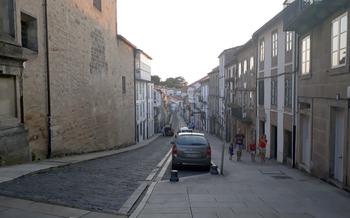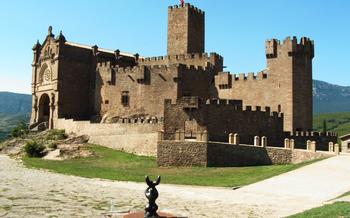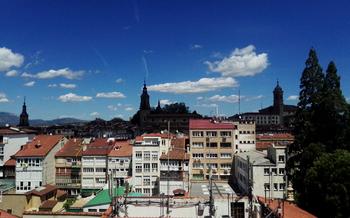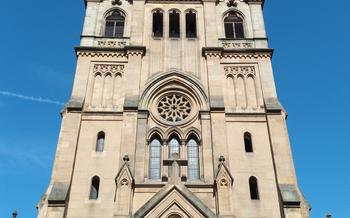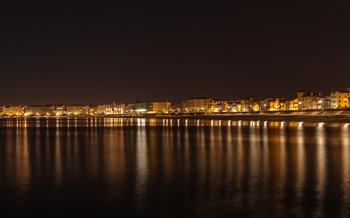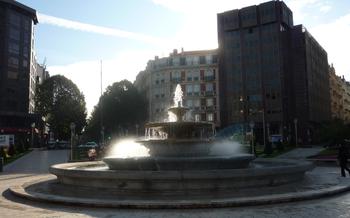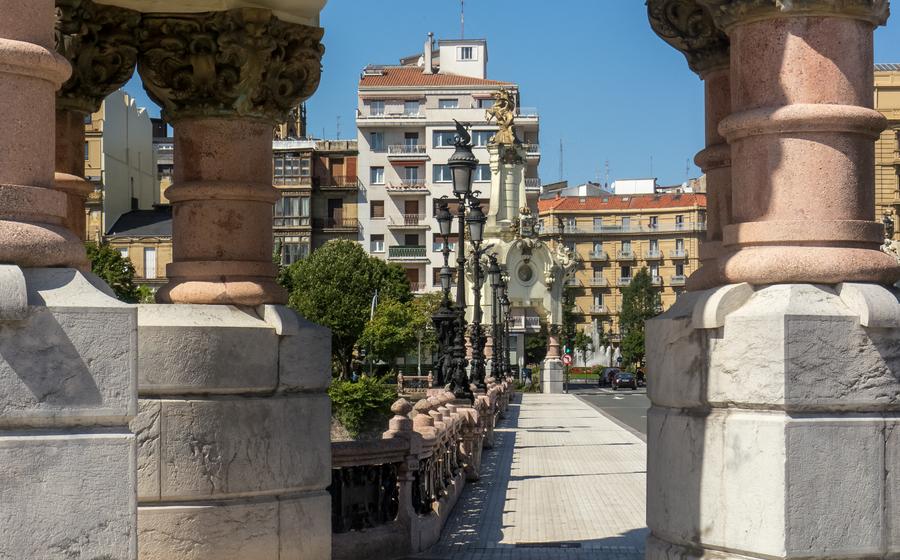
Santuario de Loyola
- Historical Significance and Architectural Beauty
- Tracing the Footsteps of Saint Ignatius of Loyola
- Exploring the Sanctuary Grounds
- The Basilica: A Masterpiece of Baroque Architecture
- The Chapel of Saint Ignatius: A Place of Reverence
- The Casa Natal de San Ignacio: The Saint's Humble Beginnings
- The Museum of the Santuario: Unveiling the History
- The Pilgrim's Path: A Journey of Faith
- The Sanctuary as a Pilgrimage Site: A Sacred Destination
- The Town of Azpeitia: A Basque Gem
- Local Festivals and Celebrations: Immerse in Basque Culture
- Getting to the Santuario de Loyola: A Seamless Journey
- Practical Tips for Visitors: Making the Most of Your Visit
- Insider Tip: Unveiling Hidden Gems
Historical Significance and Architectural Beauty
The Santuario de Loyola holds immense historical and architectural significance. Founded in the 16th century, it is dedicated to Saint Ignatius of Loyola, the founder of the Jesuit order. The sanctuary is built on the site where Saint Ignatius was born, and it has since become a major pilgrimage site for Catholics worldwide. The architectural style of the sanctuary is a blend of Renaissance and Baroque, showcasing intricate carvings, vaulted ceilings, and stunning frescoes. The complex includes several notable landmarks and structures, including the basilica, the chapel of Saint Ignatius, the Casa Natal de San Ignacio, and the museum of the sanctuary.
Tracing the Footsteps of Saint Ignatius of Loyola
The life story of Saint Ignatius of Loyola, the founder of the Society of Jesus, is intimately intertwined with the Santuario de Loyola. Born in the nearby town of Azpeitia in 1491, Ignatius experienced a profound spiritual awakening after being wounded in battle. This transformative experience led him on a journey of self-discovery and religious devotion, culminating in the founding of the Jesuit order in 1540.
His connection to the sanctuary is deeply personal, as it stands on the very site where he spent his childhood and early adulthood. The birthplace of Saint Ignatius, a 15th-century farmhouse known as the Casa Natal de San Ignacio, is located just a short walk from the sanctuary. Here, visitors can gain insights into the humble beginnings of this influential figure and trace the roots of his spiritual transformation.
The legacy he left behind is vast and enduring. Saint Ignatius's teachings on spirituality and religious devotion have influenced countless individuals throughout history, and the Jesuit order he founded has become one of the largest and most influential religious orders in the world. His writings, particularly the "Spiritual Exercises," have become a cornerstone of Catholic spirituality and continue to guide seekers on their own journeys of faith.
Exploring the Sanctuary Grounds
The Santuario de Loyola boasts a sprawling complex of buildings and outdoor spaces, each playing a vital role in the pilgrimage experience. The layout of the complex is designed to guide visitors on a journey of faith and discovery.
Notable landmarks within the sanctuary include the Basilica, the Chapel of Saint Ignatius, and the Casa Natal de San Ignacio (the birthplace of Saint Ignatius). These structures showcase different architectural styles and periods, reflecting the rich history of the site.
The gardens and natural surroundings of the sanctuary provide a serene oasis for contemplation and reflection. Visitors can stroll through the manicured lawns, admire the colorful flowerbeds, and take in the breathtaking views of the surrounding countryside. The gardens offer a peaceful escape from the hustle and bustle of everyday life, inviting visitors to connect with nature and find inner peace.
Accessibility for visitors is a key consideration at the Santuario de Loyola. The complex is wheelchair-accessible, ensuring that everyone can fully experience the sanctuary's sacred spaces. Visitors can also take advantage of guided tours, which provide insights into the history, architecture, and religious significance of the site.
The Basilica: A Masterpiece of Baroque Architecture
Standing tall and resplendent within the Santuario de Loyola, the Basilica of St. Ignatius of Loyola is a testament to the glory of Baroque architecture. Its imposing façade, adorned with intricate carvings and sculptures, beckons visitors to step into a world of artistic grandeur. The doorway, flanked by elegant columns, provides a glimpse into the lavishness that awaits inside.
The interior of the basilica is an explosion of Baroque opulence, where every surface seems to burst with intricate details. The walls and ceilings are adorned with frescoes and paintings depicting scenes from the life of Saint Ignatius and other religious figures. The main altar, a masterpiece of Baroque artistry, is a focal point of the basilica, with its elaborate carvings, gleaming gold leaf, and vibrant colors.
The dome of the basilica is a testament to the architectural prowess of the Baroque era. Its intricate designs, featuring intricate patterns and motifs, create a sense of awe and wonder. The interplay of light and shadow through the stained glass windows illuminates the interior, casting a warm and ethereal glow throughout the basilica.
The Chapel of Saint Ignatius: A Place of Reverence
Nestled within the heart of the sanctuary, the Chapel of Saint Ignatius stands as a beacon of reverence and devotion. This sacred space holds immense significance for pilgrims and visitors seeking spiritual connection. At the center of the chapel lies the silver urn, a magnificent testament to the life and legacy of Saint Ignatius. Within this ornate vessel, his remains rest, a symbol of his enduring presence and guidance.
The altar, adorned with intricate carvings and shimmering gold leaf, serves as a focal point for prayer and contemplation. It is here that the faithful gather, seeking solace and inspiration from the life of Saint Ignatius. The altar's symbolic representations, including the lily and the sword, evoke his virtues of purity and strength.
The Casa Natal de San Ignacio: The Saint's Humble Beginnings
Nest the birthplace of Saint Ignatius of Loyola, offers a glimpse into the humble origins of the revered saint. This 15th-century farmhouse exudes an aura of simplicity and tranquility, inviting visitors to step back in time and connect with the life of Saint Ignatius.
Inside the restored farmhouse, visitors can explore the various rooms that once housed the Loyola family. Interactive exhibits and displays bring to life the childhood and early life of Saint Ignatius, shedding light on the formative experiences that shaped his spiritual journey.
Through these exhibits, visitors gain insights into the challenges and devotions that influenced Saint Ignatius' decision to dedicate his life to serving God. The Casa Natal serves as a poignant reminder of the saint's humble beginnings and the profound impact he would later have on the world as the founder of the Society of Jesus.
The Museum of the Santuario: Unveiling the History
Nestled within the confines of the sanctuary complex, the Museum of the Santuario stands as a testament to the rich history and spiritual significance of the site. Through a captivating array of exhibits, artifacts, and interactive displays, the museum invites visitors to delve into the captivating narrative of the Santuario de Loyola.
The exhibits chronologically showcase the sanctuary's evolution from its humble beginnings to its current status as a renowned pilgrimage destination. Visitors can trace the footsteps of Saint Ignatius of Loyola, gaining insights into his life, his connection to the sanctuary, and the profound impact he has had on the region.
Among the museum's highlights are a collection of religious objects, manuscripts, and personal belongings that once belonged to Saint Ignatius. These artifacts provide a tangible connection to the saint's life and his unwavering devotion. Interactive displays further enhance the experience, allowing visitors to engage with the history of the sanctuary in a dynamic and immersive manner.
The Museum of the Santuario serves as a valuable resource for pilgrims and history enthusiasts alike, offering a deeper understanding of the spiritual and cultural significance of this sacred site. Through its captivating exhibits and interactive displays, the museum invites visitors to embark on a journey of discovery, uncovering the hidden stories and treasures of the Santuario de Loyola.
The Pilgrim's Path: A Journey of Faith
For those seeking a deeper connection to their faith, the Pilgrim's Path offers a unique opportunity to retrace the steps of Saint Ignatius and embark on a spiritual journey. This ancient route, stretching approximately 680 kilometers, begins in the Basque Country and culminates at the Santuario de Loyola.
Along the way, pilgrims traverse diverse landscapes, passing through picturesque villages, rolling hills, and lush forests. The path is dotted with historical landmarks and places of interest, each holding a special significance in the life of Saint Ignatius. Chapels, churches, and monasteries provide places for reflection and prayer, while quaint villages offer opportunities to interact with locals and experience Basque culture.
For those undertaking the pilgrimage, there are various accommodations available along the route, ranging from traditional albergues (pilgrim hostels) to cozy guesthouses. Whether traveling solo or in a group, pilgrims can find a welcoming community and support from fellow travelers.
Whether seeking spiritual enlightenment, a physical challenge, or a chance to immerse oneself in the Basque countryside, the Pilgrim's Path offers a transformative experience that will leave a lasting impact on any traveler.
The Sanctuary as a Pilgrimage Site: A Sacred Destination
For centuries, the Santuario de Loyola has been a sacred destination for pilgrims from around the world. Pilgrims are drawn to the sanctuary to pay homage to Saint Ignatius of Loyola, the founder of the Society of Jesus, and to seek spiritual guidance and inspiration. The sanctuary is a place of deep devotion and reverence, where pilgrims can connect with their faith and experience the transformative power of pilgrimage.
The sanctuary's historical significance as a pilgrimage site is deeply rooted in the life of Saint Ignatius. After his conversion, Ignatius spent many years at the sanctuary, praying, meditating, and discerning his future path. He found solace and guidance within the sanctuary walls, and it was here that he received the inspiration to found the Society of Jesus.
Pilgrimages to the sanctuary typically involve a variety of rituals and traditions. Pilgrims often walk the Pilgrim's Path, a 65-kilometer route that begins in the town of Loyola and ends at the sanctuary. Along the way, pilgrims can visit landmarks associated with Saint Ignatius' life, such as the birthplace of Saint Ignatius and the cave where he spent time in prayer and contemplation.
Upon reaching the sanctuary, pilgrims often participate in religious ceremonies and services, such as Mass, confession, and prayer. They may also visit the Chapel of Saint Ignatius, where the saint's remains are interred, and the Museum of the Santuario, which houses a collection of artifacts and documents related to the history of the sanctuary and the life of Saint Ignatius.
The Santuario de Loyola offers a unique and profound experience for pilgrims. It is a place where visitors can connect with their faith, deepen their spirituality, and find inspiration and guidance in their own lives.
The Town of Azpeitia: A Basque Gem
Nestled in the heart of the Basque Country, the town of Azpeitia is an enchanting fusion of history, culture, and natural beauty. Situated a mere stone's throw from the Santuario de Loyola, Azpeitia invites visitors to delve into the rich tapestry of Basque heritage.
For history enthusiasts, a stroll through Azpeitia's cobblestone streets reveals a treasure trove of architectural wonders. The 16th-century Town Hall, with its ornate façade and intricate carvings, stands as a testament to the town's enduring legacy. The Church of San Sebastian, a Gothic masterpiece, boasts an awe-inspiring altarpiece and a collection of religious artifacts that transport visitors back in time.
Azpeitia is renowned for its vibrant Basque traditions, which are proudly showcased throughout the year. The town's annual festivals erupt with a kaleidoscope of colors, music, and dance, as locals don traditional Basque attire and celebrate their deep-rooted heritage. Visitors can indulge in culinary delights such as succulent grilled meats, freshly caught seafood, and the region's signature pintxos, tantalizing morsels that burst with Basque flavors.
Azpeitia's charm extends beyond its historic center, as the town is surrounded by breathtaking natural landscapes. Lush forests, rolling hills, and meandering rivers create a picturesque backdrop for outdoor enthusiasts. Whether hiking through the verdant valleys, cycling along scenic trails, or simply relaxing in one of the many parks, Azpeitia offers a sanctuary for nature lovers.
With its rich history, vibrant culture, and stunning surroundings, Azpeitia is an ideal destination for those seeking an authentic Basque experience. Whether exploring the town's architectural gems, immersing oneself in its festive traditions, or savoring the local cuisine, Azpeitia promises an unforgettable journey into the heart of Basque Country.
Local Festivals and Celebrations: Immerse in Basque Culture
The town of Azpeitia comes alive during its annual festivals and celebrations, offering a vibrant glimpse into the Basque culture and traditions. The most prominent event is the San Ignacio Festival, held in July to honor the town's patron saint. The festival features colorful processions, traditional Basque dances, music performances, and a lively fairground.
Visitors can indulge in local culinary delights at food stalls lining the streets, savoring traditional Basque dishes such as pintxos, txakoli wine, and freshly grilled seafood. The streets buzz with excitement as locals and visitors alike participate in the festivities, creating a warm and welcoming atmosphere.
Immerse yourself in the Basque culture by joining the locals in traditional dances like the aurresku and dantza, performed to the rhythm of Basque music. These energetic dances showcase the Basque heritage and provide a captivating spectacle for visitors.
Attending a local festival in Azpeitia is an exceptional opportunity to connect with the Basque people, experience their vibrant traditions, and create lasting memories of your visit to the Santuario de Loyola and the Basque Country.
Getting to the Santuario de Loyola: A Seamless Journey
Reaching the Santuario de Loyola is a breeze, thanks to its strategic location and well-connected transportation system. Whether you prefer the convenience of public transport, the flexibility of driving yourself, or the insights of a guided tour, there are options to suit every traveler.
From major cities like Bilbao and San Sebastián, regular buses and trains offer a comfortable and affordable journey to Azpeitia, the town where the sanctuary is located. The train station is just a short walk from the sanctuary, while the bus stop is right outside.
For those who prefer the independence of driving, the sanctuary is easily accessible via the A-8 motorway. Ample parking is available near the sanctuary, ensuring a hassle-free visit.
Guided tours are an excellent option for those seeking a deeper understanding of the sanctuary's history and significance. These tours, often led by local experts, provide insightful commentary and anecdotes, enriching the visitor experience.
To ensure a seamless journey, visitors can check the official website of the sanctuary or local tourism boards for up-to-date information on schedules, fares, and any potential disruptions.
Practical Tips for Visitors: Making the Most of Your Visit
To fully immerse yourself in the sacred atmosphere of the Santuario de Loyola, it's advisable to allocate at least half a day for your visit. This will allow ample time to explore the sanctuary grounds, visit the basilica, the chapel, and the museum, and soak in the tranquil ambiance of the gardens.
For a hassle-free experience, consider joining a guided tour. These tours offer insightful commentary on the history and significance of the sanctuary, ensuring you don't miss any key highlights.
The sanctuary is wheelchair accessible, with ramps and elevators providing easy movement throughout the complex. Strollers are also permitted, making it convenient for families with young children.
While the sanctuary welcomes visitors from all backgrounds and beliefs, it's essential to be respectful of the religious significance of the site. Dressing modestly and maintaining a quiet demeanor are recommended during your visit.
To capture the essence of the sanctuary's beauty, plan your visit for the early morning or late afternoon, when the soft golden light casts a magical glow on the architecture and gardens.
Remember to bring comfortable shoes as you'll be doing a fair amount of walking. And don't forget your camera to capture the stunning vistas and architectural details that will undoubtedly take your breath away.
Insider Tip: Unveiling Hidden Gems
Beyond the main attractions of the Santuario de Loyola, there are hidden gems waiting to be discovered by curious travelers. Embark on a scenic journey through the surrounding countryside, where rolling green hills, picturesque villages, and breathtaking views await. Immerse yourself in the local Basque culture by seeking out authentic restaurants that serve traditional dishes passed down through generations. The flavors of the region will tantalize your taste buds and leave you craving for more.
To truly embrace the vibrant spirit of the Basque Country, attend a local festival or celebration. These events are a showcase of Basque traditions, where music, dance, and colorful costumes fill the streets. Engage with the friendly locals, who are always eager to share their stories and customs. As you explore Azpeitia, keep an eye out for unique souvenirs and handicrafts that reflect the region's rich heritage. These treasures will serve as lasting mementos of your pilgrimage to the Santuario de Loyola.

